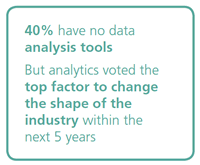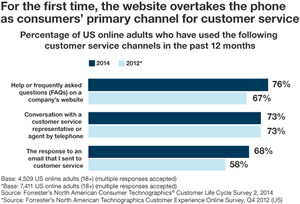At the 2015 edition of the Customer Contact Expo in London, several keynotes and workshops stood out. One of them, presented by Dimension Data’s Paul Scott (read an interview) had a title that leaves little room for interpretation: ‘Go Digital or Die!’.
It’s a message that could apply to many organizations and industries. Especially to those lagging behind and failing to catch up with the changed behavior and expectations of people (workers, consumers, other stakeholders) who, as we know, use more digital channels than ever before. “Go digital or die” has been used in various contexts and has become a bit of an often repeated message in this age of digital transformation.
However, the ‘go digital or die’ message this year is mentioned very often in the context of the contact center. Take Dimension Data’s latest ‘Global Contact Centre Benchmarking Report‘. The title of the introduction: ‘Engagement models – go digital, or die’.
Integrated digital channel support in the contact center is a must
Two months after having announced the report in a blog post called ‘Contact centres need to go digital…or die‘, Dimension Data was joined by Forrester’s Kate Leggett, who wrote a blog post, titled – indeed – ‘Contact Centers Must Go Digital Or Die’. Forrester also released a report carrying the same name and Kate Legget has been conducting several webinars around the ‘digital or die’ message. It certainly is a wake-up call that is hard to overlook. I guess no one wants their contact center to perish.
But why this message now? And what do Dimension Data and Forrester mean? After all, haven’t we been talking about and integrating digital support channels and technologies to serve the customer for ages?
In 2009, for instance, a poll by YouGov in the UK showed that 96% of contact center managers said they supported email, 65% offered web self-service, 27% SMS requests, 20% social media (including Twitter) and 11% offered support for instant messaging and online chat. To put things in perspective: those are pretty impressive numbers, especially as the same report showed that only 70% of customers used email to seek support, web-self service was used by 43%, social media by only 4% and SMS a meager 3%. So, what’s the issue?
‘Digital or die’ goes beyond supported channels: the challenges at hand
Well, there are numerous reasons why ‘go digital or die’ is a recurring message. Customers have changed and offering support for several of the ‘digital’ channels we just mentioned certainly doesn’t mean that support meets the expectations customers today have. Let’s take a look at some of the key challenges
The exponential growth of digital contact channels and the isolation challenge
While many contact centers were relatively early to embrace digital contact channels, most weren’t.
Moreover, the use of digital channels for customer service has been growing exponentially in recent years, along with the advent and adoption of new channels.
Dimension Data found that, should the evolution continue at its current pace, digital will overtake voice-based contact within two years. What we have also clearly seen over the years – and still see today – is that many support channels too often continue to live in perfect isolation.
The critical role of knowledge management

Despite the support of digital and social channels by contact centers, several crucial customer service success factors have been overlooked. One of them is the lack of good knowledge management as Kate Leggett writes.
According to Leggett half of contact centers don’t use knowledge management. What this essentially means is that all too often self-service equals basic FAQs that totally underwhelm and agents who don’t have access to the information they need, regardless of support channel.
The optimization of self-service
Customers really want access to support via digital channels without the intervention of agents unless they don’t find what they seek at the first contact or something goes wrong, the reason why assisted self-service in reality matters so much.
Self-service is indeed booming. According to Forrester Research, for the first time ever the website (FAQs, self-help) has overtaken the phone as consumers’ primary channel for customer service in the US.
Truth to be told: it’s a key investment area for contact centersfor over a decade but ‘just offering it’ in an underperforming way simply doesn’t cut it anymore. Hence the need of better knowledge management and better knowledge bases: both for agents and self-servicing customers.
Data, analytics and the customer experience

Another big challenge is analytics.
There is a need to move away from transactional measures and with customer experience being the number one strategic performance measure according to Dimension Data, a shift towards business KPIs and better interaction analytics is inevitable.
As reported previously, Dimension Data found that analytics will be key in the next 5 years, but 40% of contact centers have no capability today.
Digital and the contact center agent
‘Go digital or die’ obviously is mainly about the clear growth of digital channels and the expectations of channel-agnostic customers who simply want fast and good customer service across the digital channels they use.
The stakes are even higher if we know that this so-called digital customer is less loyal than ever before as another speaker at the expo, CEB’s Matt Dixon says (note: CEB invented the Customer Effort Score and stresses the importance of ease as you can read in our interview with Matt Dixon) .

Digital doesn’t mean inhuman however. On the contrary, as the phone becomes a bit of a last resort for ‘digitally unserved’ customers the human factor remains crucial.
As we know, the role of contact center agents will continue to change and in this new ‘digital or die’ era that also means having the knowledge management, customer interaction tools and integrated systems that enable them to meet the demands of the ‘digital’ customer.
At least as important as the technologies and channels are training, management, measurement and mastering the skillset that empowers agents to thrive in this more integrated and ‘digital first’ environment with mobile continuing to drive change.
As Matt Dixon says, ‘today’s call center is just as much a factory floor – where people are little more than cogs in the machine – as it ever was’. And that needs to change.
Top image: Shutterstock – Copyright: Gajus – All other images are the property of their respective mentioned owners.







